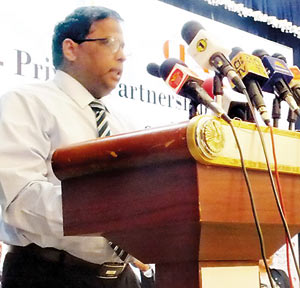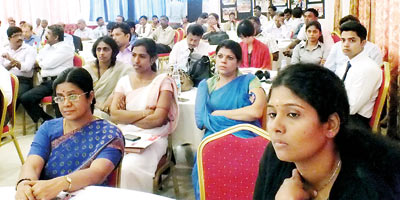Conflict-affected Jaffna private sector needs help more than its management in natural disasters
JAFFNA, Oct. 6 – At an international symposium held in Jaffna recently on disaster resilience with private public partnership, the highest government official in the district lamented that while the issues discussed were on private sector participation in mitigating the impact created by disasters, it has been the other way around as the private sector in the district is seriously affected by the man-made disaster (war) and thus the sector has to be put on its own feet, first.

N. Vethanayahan, GA Jaffna addresses the symposium.
Addressing a symposium on ‘Public Private Partnership Towards Disaster Resilience and Sustainable Development’, this call was made by N. Vethanayahan, GA/District Secretary, Jaffna.
The symposium was hosted by the Asia Pacific Alliance for Disaster Management (A-PAD) Sri Lanka that included ‘From the People of Japan’; Consortium of Humanitarian Agencies, Sri Lanka (CHA) and the Ceylon Chamber of Commerce (CCC).
A large number of delegates from Japan, Indonesia, Korea, Bangladesh and the Philippines alongside more than 70 local corporate business magnates including architects, service organisation representatives like Rotary constituted more than 200 participants.
At the symposium discussions were centred on how to assess corporate sector involvement in the disaster risk reduction and the great strides made by the corporate sector and even in Sri Lanka much work has been made towards disaster resilience. Continuing, Mr. Vethanayahan said that the district experiences floods and droughts every year. So he said that they have to continuously look after the life of the people and indicated that engaging the private sector towards this mitigation effort is excellent. He said the disaster left behind many development activities to be implemented in the district.
Jeevan Thiagarajah, National Representative, A-PAD Sri Lanka and Executive Director CHA said that disasters are also caused by poverty and geographical location and some of the deterrents are housing and land management policies for the resilient communities and said that while environmental assessments help prevent disaster, protecting human rights too plays a major role in disaster situations.
Faisal Djalal, Chairperson, Asia Pacific Alliance for Disaster Management and Advisory Board Member of the Indonesia National Platform for Disaster Risk Reduction, said that disaster management is to save life from disaster and catastrophe.
He said that the private sector should be engaged in the disaster risk reduction on a structured and planned basis and not just get some donations when disasters occur. Ms. Okai Asako, Minister, Embassy of Japan in Sri Lanka, said that this symposium is a fine example where humanitarian agencies, the corporate sector and others join together and take the leadership to bring in all the stakeholders together from different countries and to share experiences.

A section of the participants
She said that Japan is a major disaster prone country and they have played a proactive role in drawing a global framework for disaster reduction.
Uo Masakata, Planning Coordinating Director, A-PAD Japan, spoke on Multi-Sectorial Collaboration for Disaster Resilience, and said that their experience is that in disasters 77 per cent of the help comes from the neighbours and the community. In helping the victims the corporate sector and the civil society joined together in helping the disaster victims.
Ms. Athea Malaga Penaloza, National Coordinator, A-PAD Philippines spoke on ‘Central and Local Linkage for Effective Disaster Resilient Development: An Experience Sharing from the Philippines’ and said that disasters are a development issue and not humanitarian and natural disasters are a major source of risk for the poor. In disaster development gains and wealth are lost. The cost to the economy would be enormous and she pointed out that their country incurred an estimated US$12 to 15 billion in the country’s deadliest typhoon.
Firzan Hashim, Deputy Executive Director, CHA spoke on ‘Equity and inclusion in DRR: Building Resilience for All’ and pointed out that 933 million people live on US$1.25 to US$2 per day in the Asia Pacific Region and the region is the world’s most disaster prone area where 700 million are in extreme poverty and consists 60 per cent of the world’s hungry people.
In disasters, he said, an estimated 25 per cent of businesses do not reopen and economic losses are out of control and also, he indicated that women are more likely to suffer in disasters than men. The region accounted for 41 per cent of the disasters – fatalities from 1994 to 2003 were 205,388 and the numbers from 2004 to 2013 were 1.5 billion and the economic damage, he said was US$560 billion.
On the sidelines of the symposium, one of the participants, Shehan Henry, Chartered Architect, StudioSNA, Charted Architects/Designers told the Business Times his company has joined A-PAD Sri Lanka and with several other partners has started creating complete villages at Kalutara (Payagalawatte village) with18 houses and the project is now short-listed for the Geofrey Bawa Awards. In Talawakelle they have built 25 houses for the Red Cross for the estate workers who are living in line rooms. Several other such projects are in the pipe line, Mr. Henry said.


